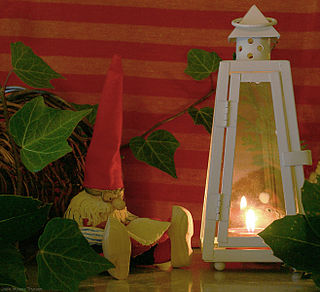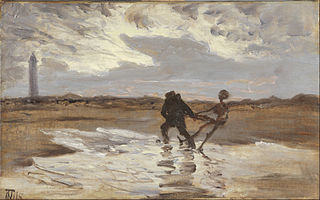
A troll is a being in Nordic folklore, including Norse mythology. In Old Norse sources, beings described as trolls dwell in isolated areas of rocks, mountains, or caves, live together in small family units, and are rarely helpful to human beings.

A nisse, tomte, tomtenisse, or tonttu is a mythological creature from Nordic folklore today typically associated with the winter solstice and the Christmas season. They are generally described as being short, having a long white beard, and wearing a conical or knit cap in gray, red or some other bright colour. They often have an appearance somewhat similar to that of a garden gnome.
Finnish mythology commonly refers of the folklore of Finnish paganism, of which a modern revival is practiced by a small percentage of the Finnish people. It has many shared features with Estonian and other Finnic mythologies, but also with neighbouring Baltic, Slavic and, to a lesser extent, Norse mythologies.

A hulder is a seductive forest creature found in Scandinavian folklore. Her name derives from a root meaning "covered" or "secret". In Norwegian folklore, she is known as huldra. She is known as the skogsrå "forest spirit" or Tallemaja "pine tree Mary" in Swedish folklore, and ulda in Sámi folklore. Her name suggests that she is originally the same being as the völva divine figure Huld and the German Holda.

The Nixie, Nixy, Nix, Näcken, Nicor, Nøkk, or Nøkken are humanoid, and often shapeshifting water spirits in Germanic mythology and folklore.

A wight is a being or thing. This general meaning is shared by cognate terms in Germanic languages, however the usage of the term varies greatly over time and between regions. In Old English, it could refer to anything in existence, with more specific usages arising in Middle English, perhaps due to the term of similar meaning in Anglo-Norman, creature. The term is widely used in modern fantasy, often to mean specifically a being which is undead.
Nordic folklore is the folklore of Denmark, Norway, Sweden, Iceland and the Faroe Islands. It has common roots with, and has been under mutual influence with, folklore in England, Germany, the Low Countries, the Baltic countries, Finland and Sápmi. Folklore is a concept encompassing expressive traditions of a particular culture or group. The peoples of Scandinavia are heterogenous, as are the oral genres and material culture that has been common in their lands. However, there are some commonalities across Scandinavian folkloric traditions, among them a common ground in elements from Norse mythology as well as Christian conceptions of the world.

Tanngrisnir and Tanngnjóstr are the goats who pull the chariot of the god Thor in Norse mythology. They are attested in the Poetic Edda, compiled in the 13th century from earlier traditional sources, and the Prose Edda, written by Snorri Sturluson in the 13th century.

The church grim is a guardian spirit in English and Nordic folklore that oversees the welfare of a particular Christian church, and protects the churchyard from those who would profane and commit sacrilege against it. It often appears as a black dog but is known to take the form of other animals. In modern times, when black dogs are kept as pets in churches and their attached parsonages, they are sometimes referred to as church grims despite not necessarily serving as guard dogs.

A Gjenganger in Scandinavian folklore was a term for a revenant, the spirit or ghost of a deceased from the grave.

"Maid Maleen" is a German fairy tale collected by the Brothers Grimm, number 198.

Ubume are Japanese yōkai of pregnant women. They can also be written as 憂婦女鳥. Throughout folk stories and literature the identity and appearance of ubume varies. However, she is most commonly depicted as the spirit of a woman who has died during childbirth. Passersby will see her as a normal-looking woman carrying a baby. She will typically try to give the passerby her child then disappear. When the person goes to look at the child in their arms, they discover it is only a bundle of leaves or large rock. The idea that pregnant women who die and get buried become "ubume" has existed since ancient times; which is why it has been said that when a pregnant woman dies prepartum, one ought to cut the fetus out the abdomen and put it on the mother in a hug as they are buried. In some regions, if the fetus cannot be cut out, a doll would be put beside her.
Vardøger, also known as vardyvle or vardyger, is a spirit predecessor in Scandinavian folklore.

Anne Olsdotter Godlid was a well-known Norwegian storyteller from Seljord, Telemark, Norway. She was noted for her excellent memory and proved an invaluable resource for collectors and Jørgen Moe, Magnus Brostrup Landstad, and Olea Crøger.
The tilberi (carrier) or snakkur (spindle) is a creature of Icelandic folklore, created by witches to steal milk. Only women can create and own them.
The Nachtkrapp is a South German and Austrian bugbear creature, cautionary tales about which are used to scare children into going to bed. Similar legends exist in Hungary, the Czech Republic, Poland, and Russia.
A troll cat is the familiar of a witch in Scandinavian folklore. Troll cats sucked milk from cows and spat it out in the witches' milk pails, and went into homes to lick up cream. Aside from cats, similar creatures include the milk rabbit, milk hare, and ball-shaped troll ball.
In Scandinavian mythology, the hug is an individual's mental life, in some contrast to the soul, a term which carries more spiritual connotations. Scandinavian languages each have a separate word for the soul that is a cognate with "soul" in English. Hug is specifically the Norwegian spelling of the word; it is rendered in Danish as hu and in Swedish as håg.

Year Walk is an adventure game developed and published by Swedish mobile game developer Simogo for iOS devices in 2013. The game is loosely based on an ancient Swedish tradition called "Årsgång". The game was ported to Windows and OS X PC platforms via Steam in 2014, and on the Wii U via eShop on 17 September 2015. It was succeeded by the free, e-picturebook Year Walk: Bedtime Stories for Awful Children.
Reidar Thoralf Christiansen was a Norwegian folklorist, archivist of the Norwegian Folklore Collection (NFS) and professor of folkloristics at the University of Oslo.











